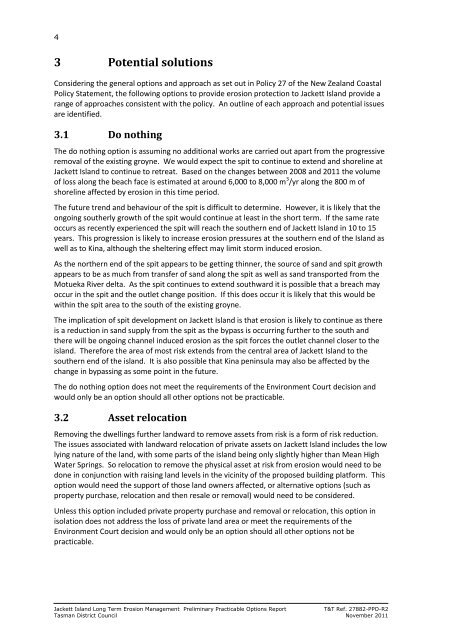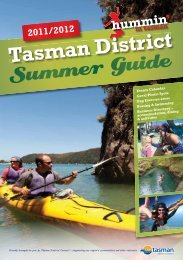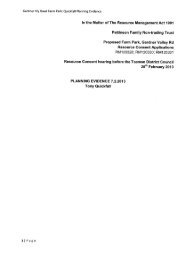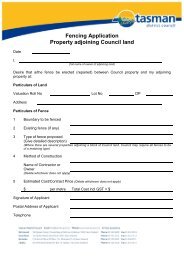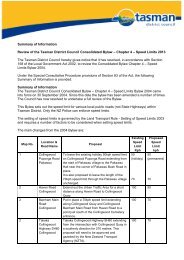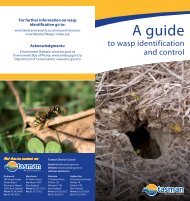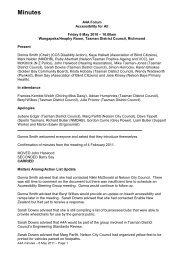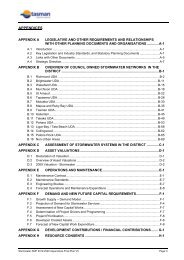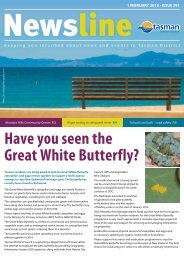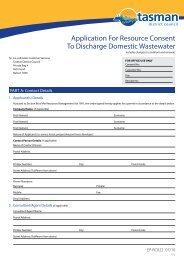RESC11-12-02 Port Motueka Groyne-Jackett Island Erosion ...
RESC11-12-02 Port Motueka Groyne-Jackett Island Erosion ...
RESC11-12-02 Port Motueka Groyne-Jackett Island Erosion ...
You also want an ePaper? Increase the reach of your titles
YUMPU automatically turns print PDFs into web optimized ePapers that Google loves.
4<br />
3 Potential solutions<br />
Considering the general options and approach as set out in Policy 27 of the New Zealand Coastal<br />
Policy Statement, the following options to provide erosion protection to <strong>Jackett</strong> <strong>Island</strong> provide a<br />
range of approaches consistent with the policy. An outline of each approach and potential issues<br />
are identified.<br />
3.1 Do nothing<br />
The do nothing option is assuming no additional works are carried out apart from the progressive<br />
removal of the existing groyne. We would expect the spit to continue to extend and shoreline at<br />
<strong>Jackett</strong> <strong>Island</strong> to continue to retreat. Based on the changes between 2008 and 2011 the volume<br />
of loss along the beach face is estimated at around 6,000 to 8,000 m 3 /yr along the 800 m of<br />
shoreline affected by erosion in this time period.<br />
The future trend and behaviour of the spit is difficult to determine. However, it is likely that the<br />
ongoing southerly growth of the spit would continue at least in the short term. If the same rate<br />
occurs as recently experienced the spit will reach the southern end of <strong>Jackett</strong> <strong>Island</strong> in 10 to 15<br />
years. This progression is likely to increase erosion pressures at the southern end of the <strong>Island</strong> as<br />
well as to Kina, although the sheltering effect may limit storm induced erosion.<br />
As the northern end of the spit appears to be getting thinner, the source of sand and spit growth<br />
appears to be as much from transfer of sand along the spit as well as sand transported from the<br />
<strong>Motueka</strong> River delta. As the spit continues to extend southward it is possible that a breach may<br />
occur in the spit and the outlet change position. If this does occur it is likely that this would be<br />
within the spit area to the south of the existing groyne.<br />
The implication of spit development on <strong>Jackett</strong> <strong>Island</strong> is that erosion is likely to continue as there<br />
is a reduction in sand supply from the spit as the bypass is occurring further to the south and<br />
there will be ongoing channel induced erosion as the spit forces the outlet channel closer to the<br />
island. Therefore the area of most risk extends from the central area of <strong>Jackett</strong> <strong>Island</strong> to the<br />
southern end of the island. It is also possible that Kina peninsula may also be affected by the<br />
change in bypassing as some point in the future.<br />
The do nothing option does not meet the requirements of the Environment Court decision and<br />
would only be an option should all other options not be practicable.<br />
3.2 Asset relocation<br />
Removing the dwellings further landward to remove assets from risk is a form of risk reduction.<br />
The issues associated with landward relocation of private assets on <strong>Jackett</strong> <strong>Island</strong> includes the low<br />
lying nature of the land, with some parts of the island being only slightly higher than Mean High<br />
Water Springs. So relocation to remove the physical asset at risk from erosion would need to be<br />
done in conjunction with raising land levels in the vicinity of the proposed building platform. This<br />
option would need the support of those land owners affected, or alternative options (such as<br />
property purchase, relocation and then resale or removal) would need to be considered.<br />
Unless this option included private property purchase and removal or relocation, this option in<br />
isolation does not address the loss of private land area or meet the requirements of the<br />
Environment Court decision and would only be an option should all other options not be<br />
practicable.<br />
<strong>Jackett</strong> <strong>Island</strong> Long Term <strong>Erosion</strong> Management Preliminary Practicable Options Report<br />
T&T Ref. 27882-PPO-R2<br />
Tasman District Council November 2011


